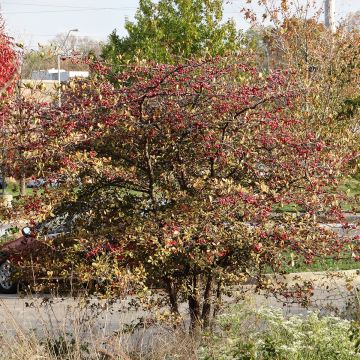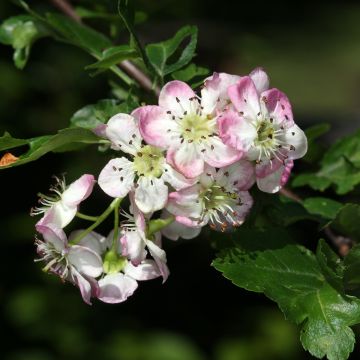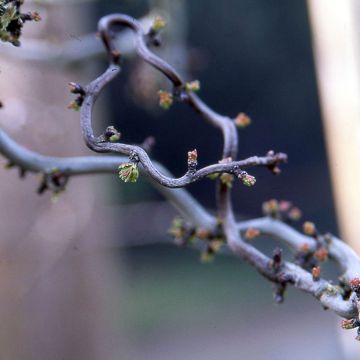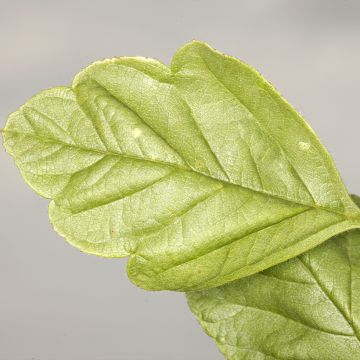

Crataegus monogyna Xanthocarpa


Crataegus monogyna Xanthocarpa
Crataegus monogyna Xanthocarpa
Crataegus monogyna Xanthocarpa
Hawthorn, Common Hawthorn, Single-seeded Hawthorn
Special offer!
Receive a €20 voucher for any order over €90 (excluding delivery costs, credit notes, and plastic-free options)!
1- Add your favorite plants to your cart.
2- Once you have reached €90, confirm your order (you can even choose the delivery date!).
3- As soon as your order is shipped, you will receive an email containing your voucher code, valid for 3 months (90 days).
Your voucher is unique and can only be used once, for any order with a minimum value of €20, excluding delivery costs.
Can be combined with other current offers, non-divisible and non-refundable.
Why not try an alternative variety in stock?
View all →This plant carries a 24 months recovery warranty
More information
We guarantee the quality of our plants for a full growing cycle, and will replace at our expense any plant that fails to recover under normal climatic and planting conditions.
Would this plant suit my garden?
Set up your Plantfit profile →
Description
The Crataegus monogyna ‘Xanthocarpa’ is a rarely offered form of Hawthorn that stands out for its yellow fruits instead of the usual red. In spring, the bush produces a multitude of single white flowers that are fragrant and arranged in clusters. In autumn, its yellow foliage provides a backdrop for its abundant fruiting, which is appreciated by birds. Like all Hawthorns, this variety is very cold-hardy and can tolerate salt spray and pollution. It can be planted without hesitation in a countryside hedge, in all regions.
The Crataegus monogyna, also known as Common Hawthorn, Single-style Hawthorn, or White Thorn, is a species native to central and southern Europe where it grows in deciduous or mixed forests, open woods, forest edges, or even open terrain (meadows). This ornamental and ecological shrub is ideal in a hedgerow or as a free-standing plant. It belongs to the large Rosaceae family. It is a spiny shrub with a long lifespan, very hard wood, reaching a height of 10 m and a spread of 6 m at maturity, with a bushy, dense, sometimes slightly disordered habit. 'Xanthocarpa' is a small tree or large shrub with a moderately fast growth rate. Eventually, it will reach a height of 3 to 6 m and a spread of 2 to 3 m. The bark of the trunk is gray-brown, becoming scaly over time, and its short stems bear thorns. Its foliage is deciduous and absent in winter. It consists of single leaves that are 2 to 5 cm long, ovate in shape, deeply divided into 5 to 7 toothed lobes. The leaf veins are divergent. The leaves are dark green and shiny on the upper surface, with a duller underside, turning yellow in autumn before falling. In May-June, numerous single white flowers appear in dense, flat clusters of 6 to 12 flowers. The flower corollas have 5 rounded petals and numerous stamens with light pink anthers that turn purple. The flowers measure 1 to 2 cm in diameter and are highly visited by bees. In September-October, numerous yellow fruits with a single stone called "haws" appear, measuring 6 to 10 mm in length. They are spherical in shape. These berries are consumed by birds.
The Crataegus monogyna ‘Xanthocarpa’ adapts to any well-drained soil, even limestone, in a sunny or partially shaded location. Not demanding and very hardy, this shrub will only require maintenance pruning in February. It will thrive in gardens that make space for nature, particularly in a hedgerow or defensive planting. It can be paired with many other flowering shrubs or ornamental fruit shrubs, such as a small-sized flowering crab apple 'Royal Beauty', an early-flowering Chinese almond 'Multiplex', a compact winged spindle 'Compactus' for its autumn colors, or a rugosa rose 'Hansa' for its beautiful fragrant magenta flowers and large decorative orange-red fruits...
Note: The White Thorn hybridizes with Crataegus laevigata (Midland Hawthorn). It was once associated with May 1st, especially in Touraine. It was used as a calming agent to treat gout and pleurisy in the Middle Ages. Be cautious about dosage, as it can cause cardiovascular problems. Its wood is used for heating and was once used for metal parts and small carpentry.
The term monogyna comes from the Latin word "monogunus", which means "with a single style". This criterion distinguishes this variety from Crataegus laevigata, which has 2 or 3 styles (pistils) and therefore 2 or 3 stones in the fruit.
Plant habit
Flowering
Foliage
Botanical data
Crataegus
monogyna
Xanthocarpa
Rosaceae
Hawthorn, Common Hawthorn, Single-seeded Hawthorn
Cultivar or hybrid
Other Hawthorn Crataegus
View all →Planting and care
The Crataegus monogyna 'Xanthocarpa' is cultivated in a sunny or semi-shaded location. It is preferably planted in autumn in any well-drained soil, even limestone, in a sunny or semi-shaded position. This variety does not tolerate very clayey and heavy soils that remain waterlogged in winter and suffocate its roots. Its frost resistance is excellent.
Hawthorn can be affected by caterpillars, aphids, rot, rust, and powdery mildew. The plant is particularly sensitive to fire blight, which can be a hindrance to planting it near apple and pear orchards. Not very demanding, this large bush will be satisfied with a balanced pruning in February. Optionally, trim the overly long branches to maintain a harmonious habit.
Planting period
Intended location
Care
Planting & care advice
This item has not been reviewed yet - be the first to leave a review about it.
Similar products
Haven't found what you were looking for?
Hardiness is the lowest winter temperature a plant can endure without suffering serious damage or even dying. However, hardiness is affected by location (a sheltered area, such as a patio), protection (winter cover) and soil type (hardiness is improved by well-drained soil).

Photo Sharing Terms & Conditions
In order to encourage gardeners to interact and share their experiences, Promesse de fleurs offers various media enabling content to be uploaded onto its Site - in particular via the ‘Photo sharing’ module.
The User agrees to refrain from:
- Posting any content that is illegal, prejudicial, insulting, racist, inciteful to hatred, revisionist, contrary to public decency, that infringes on privacy or on the privacy rights of third parties, in particular the publicity rights of persons and goods, intellectual property rights, or the right to privacy.
- Submitting content on behalf of a third party;
- Impersonate the identity of a third party and/or publish any personal information about a third party;
In general, the User undertakes to refrain from any unethical behaviour.
All Content (in particular text, comments, files, images, photos, videos, creative works, etc.), which may be subject to property or intellectual property rights, image or other private rights, shall remain the property of the User, subject to the limited rights granted by the terms of the licence granted by Promesse de fleurs as stated below. Users are at liberty to publish or not to publish such Content on the Site, notably via the ‘Photo Sharing’ facility, and accept that this Content shall be made public and freely accessible, notably on the Internet.
Users further acknowledge, undertake to have ,and guarantee that they hold all necessary rights and permissions to publish such material on the Site, in particular with regard to the legislation in force pertaining to any privacy, property, intellectual property, image, or contractual rights, or rights of any other nature. By publishing such Content on the Site, Users acknowledge accepting full liability as publishers of the Content within the meaning of the law, and grant Promesse de fleurs, free of charge, an inclusive, worldwide licence for the said Content for the entire duration of its publication, including all reproduction, representation, up/downloading, displaying, performing, transmission, and storage rights.
Users also grant permission for their name to be linked to the Content and accept that this link may not always be made available.
By engaging in posting material, Users consent to their Content becoming automatically accessible on the Internet, in particular on other sites and/or blogs and/or web pages of the Promesse de fleurs site, including in particular social pages and the Promesse de fleurs catalogue.
Users may secure the removal of entrusted content free of charge by issuing a simple request via our contact form.
The flowering period indicated on our website applies to countries and regions located in USDA zone 8 (France, the United Kingdom, Ireland, the Netherlands, etc.)
It will vary according to where you live:
- In zones 9 to 10 (Italy, Spain, Greece, etc.), flowering will occur about 2 to 4 weeks earlier.
- In zones 6 to 7 (Germany, Poland, Slovenia, and lower mountainous regions), flowering will be delayed by 2 to 3 weeks.
- In zone 5 (Central Europe, Scandinavia), blooming will be delayed by 3 to 5 weeks.
In temperate climates, pruning of spring-flowering shrubs (forsythia, spireas, etc.) should be done just after flowering.
Pruning of summer-flowering shrubs (Indian Lilac, Perovskia, etc.) can be done in winter or spring.
In cold regions as well as with frost-sensitive plants, avoid pruning too early when severe frosts may still occur.
The planting period indicated on our website applies to countries and regions located in USDA zone 8 (France, United Kingdom, Ireland, Netherlands).
It will vary according to where you live:
- In Mediterranean zones (Marseille, Madrid, Milan, etc.), autumn and winter are the best planting periods.
- In continental zones (Strasbourg, Munich, Vienna, etc.), delay planting by 2 to 3 weeks in spring and bring it forward by 2 to 4 weeks in autumn.
- In mountainous regions (the Alps, Pyrenees, Carpathians, etc.), it is best to plant in late spring (May-June) or late summer (August-September).
The harvesting period indicated on our website applies to countries and regions in USDA zone 8 (France, England, Ireland, the Netherlands).
In colder areas (Scandinavia, Poland, Austria...) fruit and vegetable harvests are likely to be delayed by 3-4 weeks.
In warmer areas (Italy, Spain, Greece, etc.), harvesting will probably take place earlier, depending on weather conditions.
The sowing periods indicated on our website apply to countries and regions within USDA Zone 8 (France, UK, Ireland, Netherlands).
In colder areas (Scandinavia, Poland, Austria...), delay any outdoor sowing by 3-4 weeks, or sow under glass.
In warmer climes (Italy, Spain, Greece, etc.), bring outdoor sowing forward by a few weeks.






























































